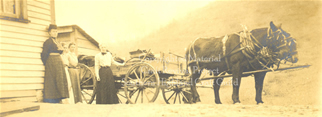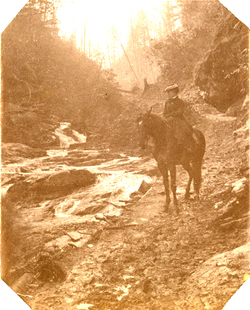A Region Defined:
Following Wagon Trails
During the first decade of the Craft Revival—from 1895 until 1905—cars were a rare sight. Travel in and out of the region was by train and, locally, by wagon or horseback. Wagons rolled over rough overland trails, sometimes bogged down by mud, blocked by fallen trees, or slowed by outcroppings of rock. Wagons or sleds were often used to deliver goods, including crafts. In his book Handicrafts of the Southern Highlands, Allen Eaton described how craftsmen took crafts to market, carrying them down off the mountain where they were made.
Allen Eaton’s Handicrafts of the Southern Highlands described craft transport in 1937:
“In these days, of course, many [crafts] can be carried out of the mountains by truck, automobile, and wagon, but others must still be brought from remote places by manback, muleback, and sled. The sled, made entirely of wood, is an invaluable homemade vehicle, which can be pulled over trails not open to wagon or cart, even if such luxury of transportation were available. The sleds loaded with chairs, and sometimes baskets, too, for they ride well together, tied on with twisted bark or ropes are pulled and pushed up and down mountain paths to a main road and then to store or settlement. One of the most spectacular and surprising sights is to meet a mule coming around a mountain trail with chairs piled high on his back and his sides bulging with them, sometimes as many as two or three dozen, all of which he has carried from some distant cabin. Nor is it unusual to see the maker himself trudging along a path with four to six chairs balanced on his back, the load to be lightened as he is able to sell or trade one or more along the way.” 1
Musician Jean Ritchie described her childhood, growing up beyond the railroad line in rural Kentucky in a terrain similar to western North Carolina. Walking was the most common way to get from one place to another.
“I walked the five or six miles across the mountains to…Troublesome Creek. You had to turn off the Ball Fork road, which was fit for a good-sized wagon, and go a little ways up Beech Fork, where you could only ride a horse through, or walk. The road wound through the deep woods, sometimes a small footpath around a bank more often going through the very bed of the branch.”
Outsiders came to the region initially by train. From the station, travel was by wagon, horseback, mule, or on foot. Ritchie recalled the arrival of Katherine Pettit, the founder of two Kentucky settlement schools. Pettit’s overland journey was slow.
“One day in late spring of 1895 a strange woman drove into Hazard in a wagon, said she had…traveled on that new railroad train to Jackson all the way from Lexington in one day, then it took her two days to get the forty miles on to Hazard with the wagon and team.” 2
School founder Olive Campbell recalled an exploratory trip that she and John Campbell made to visit Pettit at the Pine Mountain Settlement School, nearby to where Ritchie grew up. The Campbells were interested in education and visited numerous out-of-the-way communities to see mountain schools. The Campbells usually began their trip by train, in this case taking the train from North Carolina to Kentucky. Departing the station, their usual mode of travel was by wagon. But the mountainous trail over Pine Mountain was steep and, on this particular trip, icy as well. They started out on horseback, but wound up walking most of the way. With an emotional mixture of fear and awe, Olive Campbell described the dangerous and icy path through the magnificent forested landscape.
“At the end we had to walk over Pine Mountain, for the trail was too slippery for horseback. It was a long hard trip for John, climbing up the steep trail in the snow and ice. We took it slowly, with frequent stops to admire the beauty of the woods, and to catch our breath. Even after we reached the top, the down trip was not easy. We slipped and slid over the uncertain footing.” 3
Campbell and Ritchie’s comments well illustrate the obstacles facing craftsmen taking their work to market in the earliest years of the Craft Revival.
See More: See what this region looked like in the 1890s. Take this journey through western North Carolina along footpaths and wagon trails.
Allen Eaton. Handicrafts of the Southern Highlands (New York: Russell Sage, 1937) 156-157.
Jean Ritchie. Singing Family of the Cumberlands (New York: Oxford University Press, 1955) 106, 246-247.
Olive Dame Campbell. The Life and Work of John Charles Campbell: September 15, 1868 to May 2, 1919 (Madison, Wisconsin: Privately printed, 1968) 559.






